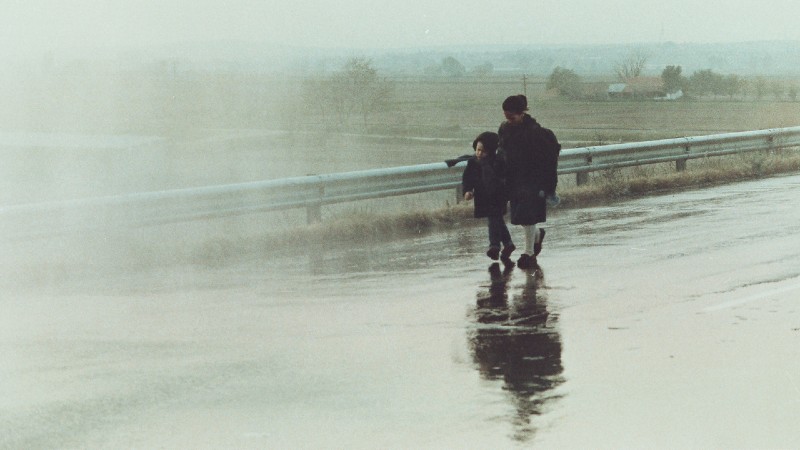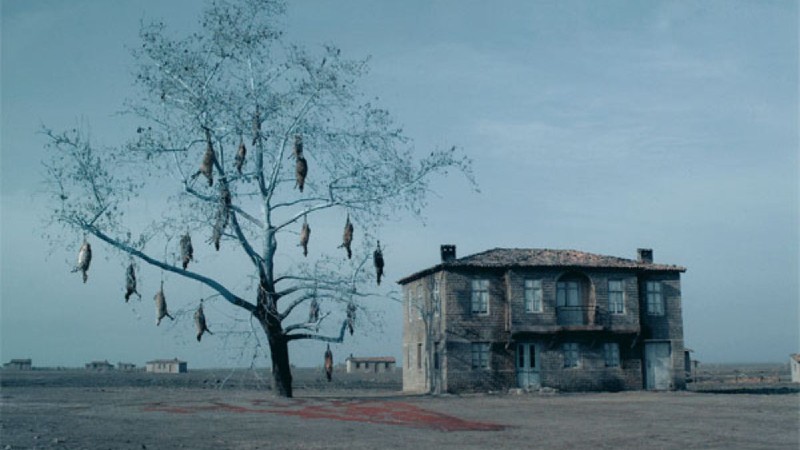




Praised by none other than Martin Scorsese as a “masterful filmmaker”, Greece’s greatest cinematic storyteller Theodoros Angelopoulos never had the kind of international success his successor, Yorgos Lanthimos, currently enjoys. His work is the very definition of “difficult” – ambitious, ambiguous, epic, standing at a distance. Yet within that difficulty and that refusal to be pinned down is an extraordinary canon, charting what feels like the entire history of Greece in the 20th and 21st centuries, often feeling like all works are part of the same ever-flowing story. With difficulty comes reward, and Angelopoulos offers rewards in spades, a deeply affecting body of work that doubles up as an epic history lesson on the modern construction of his home nation.
Born in 1935, he worked as a journalist and a film critic before becoming a director. This deep, scholarly knowledge of auteurs is evident in his filmmaking. He credits both the use of deep focus in Orson Welles’ films and the dreamlike mise-en-scene of Kenji Mizoguchi as cinematic influences, combining both their styles to create a unique approach to composition. His combination of slow camera movements, textures of fog, rain and mist, and serious inquiry into the meaning of life, prove him a true cinematic sibling of masters such as Andrei Tarkovsky, Michelangelo Antonioni and Bela Tarr.
Angelopoulos’ trademark shot is the panoramic slow pan, a five-minute-plus unbroken take with an astonishing level of group choreography. Often the past and the present are melded together within single dazzling takes, such as in the daring non-linear structure of The Travelling Players (1975) or Bruno Ganz’s character Alexander in Eternity and a Day (1998) remembering and then subsequently entering pleasanter days with his wife. This sense of history encroaching on the margins of ordinary people through well-placed and long-held camerawork can be seen today in Alfonso Cuarón’s Roma (2018), especially when it comes to the extraordinary depth of field both directors conjure up.

.
Not for the masses
Despite his obvious technical brilliance, Angelopoulos failed to reach the critical esteem of his contemporaries, perhaps because he never made a truly accessible hit. The closest he came was Landscape in The Mist (1988; pictured above) – the third film in his Trilogy of Silence – the tender tale of two Greek children who believe their father is in Germany and set off on a perilous quest to find him. Like Tarkovsky’s Stalker (1979), their intended goal is seen as a metaphor for something bigger, but the meaning of that metaphor is really up to each viewer to figure out for themselves. Yet even here the journey is endlessly circuitous, and full of symbols – such as the huge sculptured hand found in the sea – that are never truly explained. In comparison to Angelopoulos’ obfuscation, a Tarkovsky film plays like a genre exercise.
This refusal to explain is characteristic of Angelopoulos’ work, which can be notoriously difficult to follow. As Derek Malcolm said back in 2000, describing his lack of popularity: “The reasons are obvious. He is a filmmaker who refuses compromise. The slow pace and austere style of his work are utterly against current trends, and the content is invariably as formidably intellectual as it is emotional and poetic. He is, to put it bluntly, not everybody’s idea of a good night out.”
His films are steeped in 20th century Greek history, such as the Second World War and the bitter Civil War that followed – in which his own father was taken hostage – as well as contemporaneous reflections on the West Balkans. You will not see many of those sunny locales that quickly come to mind when thinking of Greece – instead he films in the barren, mountainous, often snow-capped landscapes of the North, often close to Balkan neighbours Albania and Macedonia. References to Greek theatre and myths also abound, with reenactments of plays and old tales – both literal and metaphorical – a frequent occurrence. Even his debut movie, Reconstitution (1970), is based upon the ancient myths of Atrides and Clytemnestra – something Greek audiences may pick up on, but will require the average viewer to do their homework. Soundtracking his films are often travelling bands playing songs on traditional instruments such as the santur, accordion and kemane. These are deeply personal explorations of Greek identity that steadfastly refuse to pander to the audience, to establish their context, or to even reveal character motivation until well into the movie’s runtime.
.
History repeating
Often shooting his characters from a reserved distance, and refusing to provide much real interiority, his early works achieve a Brechtian effect. Created under the watchful gaze of the Military Junta who ruled between 1967 and 1974, the first two films of the Trilogy of History, Days of ’36 (1972) and The Travelling Players, may be set in the past, but Angelopoulos used that cover in order to slyly comment on the harshness of the current government. Without a doubt, The Travelling Players is his most famous film, a 230-minute opus that depicts the travails of a travelling acting troupe between 1939 and 1952. Often drifting between time periods without warning, it is a great exploration of why it was so hard for Greece – the land that invented democracy – to establish true democracy in the present day, something that feels especially prescient now with the popularity of Golden Dawn. He considered the past and present to always be bedfellows. As he said in a press conference describing The Dust of Time (2009): “The Dust of Time is a film that treats the past as if it were in the present. It is history written in capital letters and history written in small print. We used to think of ourselves as the subjects of history. Nowadays I can’t say if we are its subjects or objects.”
These prescience is continued in perhaps his most important cycle of films, The Border Trilogy, which take place alongside the Greek-Albanian border. Greece has always had notoriously conservative border policies. Here Angelopoulos counts the brutal cost. Spanning the 1990s, these films feel urgent due to the nearby breakdown of the West Balkans. From The Suspended Step of The Stork (1991), detailing a Greek politician spotted pretending to be a refugee at a border camp, to the excesses of Ulysses’ Gaze (1995), with Harvey Keitel playing a director (a stand-in for Angelopoulos himself) searching for the first film ever shot in the Balkans, and Eternity and a Day, detailing the tender relationship between a writer at the end of his life and the young Albanian refugee he meets in the street and pledges to help, these films are a cry for humanity as well as a bitter indictment against the inhuman border policies Greece pursued during that time. Today, with the grossness of borders leading to refugees dying in the Mediterranean on a daily basis, a filmmaker with Angelopoulos’ vision and humanity would be warmly welcome.
He was cruelly struck down in a car crash filming The Other Sea, the third film of his Modern Greece trilogy. Proceeded by the astonishingly austere yet sweeping The Weeping Meadow (2004; pictured below) and its “sequel”, The Dust of Time (2009; pictured at the top of this article), a passionate blend of the sublime and the absurd, The Other Sea was intended to be set in the present day, leaving the master’s perhaps final statement on modern Greece tragically incomplete. Commenting on his death, Peter Bradshaw found this a fitting way to go, considering “so much of his work is about the unfinished story, the unfinished journey, the unfinished life, and the realisation that to be unfinished is itself part of the human mystery and an essential human birthright and burden.”

.
Cinema meets fashion
The influence of Angelopoulos’ work goes beyond cinema, and had a lasting impact in the fashion world – where being “difficult” is not seen as a hindrance but often seen as a virtue. When asked her three favourite movies by Paul Smith, Commes des Garçons designer Rei Kawakubo simply replied: “Films by Theo Angelopoulos”. Her work has been described as “anti-fashion” – that is, completely uninterested in the trends of the day, and focused entirely on developing her own austere style. This is much like how Angelopoulos sticked to the same slow style of filmmaking throughout his entire career without paying any attention to the rise of the blockbuster that occurred around the same time. Kawakubo describes sticking to the same thing over and over it as the kachikan – value system – behind her work. As she says: “I’m the kind of person who decides something and sticks to it. I started with that premise and carried on, and through the doing of it, without wavering from the kachikan.” Conventional techniques are eschewed in favour of personal vision, uniting the two artists both in style and sensibility.
Kawakubo’s 80s fashion garments, with muted colour palettes, composed mostly of greys, blacks and whites, are similar to the Orthodox dress of many of Angelopoulos’ characters. The women she gave black clothes to were described as “the crows”; likewise Peter Bradshaw says that in The Weeping Meadow “black-clad figures move across the horizon like crows.” Additionally, both artists are preoccupied by nothingness, absences. The roving camera of Angelopoulos always hints at something just out or reach while Kawakubo’s pieces, such as her 1982 simple black sweater marked with holes were as famous for what wasn’t there, as what was. They both know that this technique can easily be a strength, and going against conventional techniques can often locate a higher truth. The key difference between them however, is while Angelopoulos’ influence can be found in a handful of directors such as Lav Diaz and Carlos Reygadas, Kawakubo’s designs significantly altered the fashion market for young, independent-minded women. Its a twist of fate that befits one of the most unorthodox directors of all: his steadfast, and seemingly un-copyable style serving as inspiration for one of the most famous fashion designers of all, one who has created a line of work that revolutionised the world of clothing design. If anything, this proves that his legacy is far from finished.
…
.
A short selection of the films by Angelopoulos:
1. Reconstruction (1970):
Angelopoulos’ debut is a remarkably accomplished work, a tale of marital infidelity that doubles up as a documentation of a remote mountain town. Markedly different to its later work, the police procedural elements seem to have played on influence on Nuri Bilge Ceylan.
.
2. The Travelling Players (1974):
An epic depiction of both a people and a time, Angelopoulos hails the birth of modern Greece. Perhaps the best summation of his aesthetic; the music hall scene is one of the greatest moments in cinema.
.
3. Landscape in the Mist (1988):
This touching tale of two adolescent children travelling to Germany is easily Angelopoulos’ most moving film, containing images of both extraordinary beauty and tenderness. His first film to be distributed in the United States.
.
4. The Suspended Step of The Stork (1991):
Depicting one journalists attempts to unmask a former Greek politician hiding in a refugee border town, The Suspended Step of The Stork creates an entire eco-system of stranded Albanians, Kurds and Turks – indicting Greece’s poor immigration policies in the process.
.
5. Eternity and a Day (1998):
Bruno Ganz gives one of his greatest performances as a writer nearing the end of his life who decides to help a stranded Albanian refugee boy. Both a fine character study and a savage societal critique, it won the Palme D’or at Cannes.
.
This is the first one is a series of articles in a partnership with the magazine Doesn’t Exist. Just click here for more information, and to order your print edition right now!






